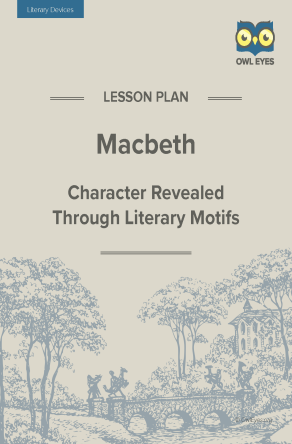Macbeth Literary Devices Lesson Plan
- 26 pages
- Subject: Character Analysis, Literary Devices, Motif, Symbols, Themes, Lesson Plans and Educational Resources
- Common Core Standards: RL.9-10.1, RL.9-10.2, RL.9-10.3, RL.9-10.4
- Grade Levels: 9, 10, 11, 12
Additional Macbeth Resources
Product Description
Character Revealed Through Literary Motifs
This lesson plan focuses on Shakespeare’s use of literary motifs in developing the character of Lady Macbeth. Students will examine several motifs in the play and analyze what they reveal about her and how they contribute to symbolism and theme in the drama. In studying the motifs, students will be better able to describe the dynamic nature of Lady Macbeth’s character, her psychological and emotional disintegration at the play’s conclusion, and how her destruction contributes to themes in the play.
Skills: close reading, contrasting story elements, interpreting symbolism, drawing inferences from the text
Learning Objectives: By the end of this lesson, students will be able to
- define “motif” and discuss major motifs in the play: blood, sleep, and deception (false appearance vs. reality).
- contrast Lady Macbeth’s character in Act II with Act V and describe the changes in her mental and emotional state.
- describe how the dynamics in Lady Macbeth’s character, as revealed through the motifs, contribute to themes in the play.
- interpret symbolism developed through the motifs and discuss how it contributes to themes in the play.
About This Document
Owl Eyes lesson plans have been developed to meet the demanding needs of today’s educational environment and bridge the gap between online learning and in-class instruction. The main components of each plan include the following:
- An introduction to the text
- A step-by-step guide to lesson procedure
- Discussion questions and group-learning activities
- Previous and following lesson synopses for preparation and extension ideas
- A collection of handouts and worksheets complete with answer keys
Each of these comprehensive, 60-minute plans focus on promoting meaningful interaction, analytical skills, and student-centered activities, drawing from the Common Core Standards for English Language Arts and the expertise of classroom teachers.
Introduction to the Lesson
Macbeth, the courageous general destroyed by his ambition to rule Scotland, is the central character in Shakespeare’s tragedy and generally the primary focus of literary analysis of the drama.
Lady Macbeth, however, who is instrumental in Macbeth’s murdering King Duncan and assuming the throne, is as complex a character, as villainous as her husband, and arguably more responsible than he is for Duncan’s death. Even more ambitious than Macbeth and unrestrained by loyalty, compassion, or principles of moral behavior, Lady Macbeth feeds his ambition, carefully plans the king’s murder, and manipulates Macbeth into committing it when he has a change of heart. She appears to be unaffected by the horror of Duncan’s being slaughtered in his sleep and by the ensuing horrors that unfold following his murder.
As the play concludes, however, Lady Macbeth apparent imperviousness to the results of her and Macbeth’s treachery proves to be an illusion. Ultimately overwhelmed by fear, guilt, and remorse, she commits suicide. The contrast between Lady Macbeth’s character at the beginning of the play and in the conclusion is a striking indication of the psychological and emotional disintegration that occurs within her as her character is developed. Her destruction, as well as Macbeth’s, contributes to major themes in the drama.
Worksheet Excerpt From the Lesson
Interpreting Lady Macbeth Through Motifs in Act II
Confer with others in your group while you complete this activity. Discuss the questions and the passages, and refer to the text as you work through the handout. Support your answers with details from the text.
I. Sleep Motif (Act II, Scene ii) After murdering King Duncan, Macbeth is in a highly disturbed state. He reports to Lady Macbeth that he heard a voice cry “Glamis hath murdered sleep, and therefore Cawdor / Shall sleep no more: Macbeth shall sleep no more.”
-
What does Lady Macbeth reply?
-
What does she seem most concerned about regarding Macbeth’s report of what he heard after Duncan’s murder? What is she apparently not concerned about?
-
What seems to be her attitude about losing sleep over killing the king?
II. Blood Motif (Act II, Scene ii)
-
When Lady Macbeth observes King Duncan’s blood on Macbeth’s hands, what does she tell him to do? Why would she order him to do it?
-
After noticing that Macbeth has carried the bloody daggers away from the site of Duncan’s murder, what instructions does she give Macbeth?
-
After Macbeth refuses to return to the king’s bedchamber and look again at his body, Lady Macbeth says the following:
Give me the daggers. The sleeping and the dead Are but as pictures. Tis the eye of childhood That fears a painted devil. If [Duncan] do bleed, I’ll gild the faces of the grooms withal, For it must seem their guilt.
How does she seem to feel about Duncan’s dead body and his blood? What words would you use to describe her attitude about them?
- After returning the bloody daggers to Duncan’s bedchamber and presumably smearing Duncan’s blood on his drugged attendants, Lady Macbeth comes back to Macbeth, her own hands now covered with blood. She says to him, “A little water clears us of this deed.”
What does her statement imply regarding her attitude about having committed a bloody murder?
III. Sum it up
Write a sentence or two describing what is revealed about Lady Macbeth through the motifs of blood and sleep in act II, scene II.







